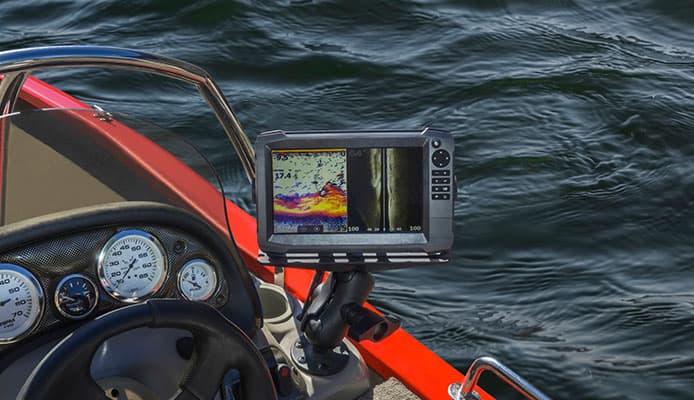
Fishing excursions are more productive and enjoyable when you can see what is below the water surface. A fish finder gives you the ability to see underwater and maximize your fishing expeditions. With a budget of under $300, you can get a high quality fishing sonar that will give you an accurate and clear view of the fish and the world below the surface and help you land more fish.
You can even get a fish finder with built-in GPS you can use to navigate unfamiliar waters and mark lucrative fishing spots you’d like to come back to. Below are the top 10 fish finders you can get for less than $300. They range from castable sonar units to chart plotters. Whether you fish from the shores, off a kayak or jig through ice holes, you will find the best fish finder under 300 for your needs here.
OUR TOP PICK
Humminbird HELIX 5
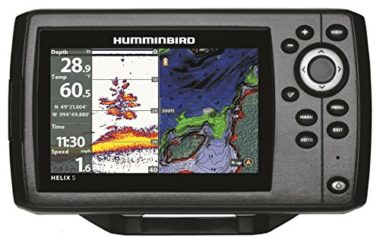
- Stand Out Features - Why We Love It
- CHIRP dual beam PLUS sonar
- Built-in GPS for positioning and mapping
- Chart plotting with built-in Anima cartography
- Real-time sonar
- Displays speed data
- 5-inch color display
- Temperature alarm
Dimensions: 1.13 x 7.55 x 4.28 in
Weight: 2.5 lbs
Power Output: 500 watts (RMS), 4000 watts (PTP)
Display Resolution: 800H x 480V
Maximum Depth: 1500 ft and 2500 ft
EDITORS CHOICE
Deeper PRO+ Smart
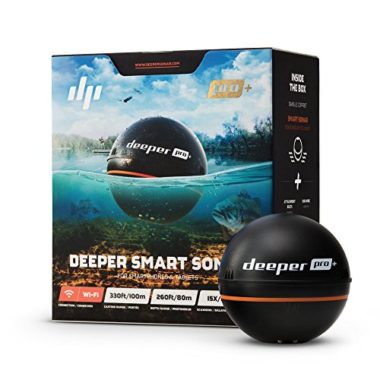
- Stand Out Features - Why We Love It
- Castable fish finder, perfect for shore fishing
- Traditional flasher display for vertical jigging
- Built-in GPS for creating bathymetric maps
- Dual beam sonar frequency
- Small and lightweight, highly portable
- Boat mode for trolling
- Suitable for fresh and saltwater
Dimensions: 2.6 x 2.6 x 2.6 in
Weight: 3.52 oz
Operating Frequencies: 90kHz and 290kHz
Beam Angles: 15° or 55°
Operating Temperature: -4°F to 104°F
BEST VALUE
Garmin Striker 4 GPS
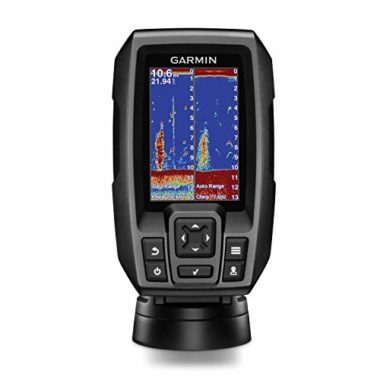
- Stand Out Features - Why We Love It
- Great for boat, kayak and canoe fishing
- Classic flasher for ice fishing and jigging
- Best unit on a tight budget and fantastic value
- ClearVu scanning sonar
- High-sensitivity GPS
- Accurate depth finder in both deep and shallow waters
- Displays boat speed data
- Lightweight and comes with a protective portable kit
Dimensions: 3.6 x 1.6 x 5.9 in
Weight: 8 oz
Operating Frequencies: 50/200 kHz
Transmit Power: 200 W
Maximum Depth: 1,600 ft freshwater, 750 ft saltwater.
Garmin Striker 4cv
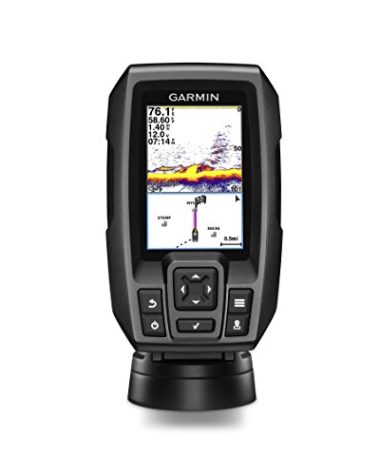
- Stand Out Features - Why We Love It
- Compact size, perfect for kayaks and canoes
- Garmin CHIRP ClearVu sonar technology
- Built-in high-sensitivity GPS
- Built-in flasher for ice fishing
- Speed data display
- User-friendly button control
Dimensions: 3.6 x 1.6 x 5.9 in
Weight: 8 oz
Transmit Power: 300W
Maximum Depth: 1,750 ft freshwater, 830 ft saltwater
HawkEye Fishtrax 1C
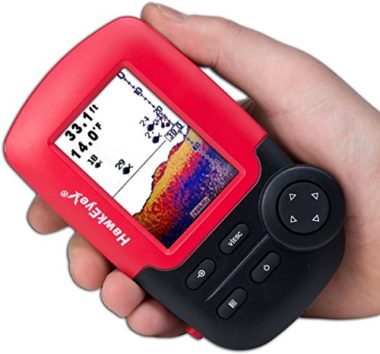
- Stand Out Features - Why We Love It
- Portable and mountable fish finder
- Digital ice fishing flasher with real time display
- Two operating frequencies and dual-beam sonar
- Audible depth and fish alarms
- Auto-zoom bottom tracking
- High definition color display
- Utilizes AAA batteries
- Comes with a protective carrying case
Dimensions: 6 x 3 x 2 in
Weight: 10.2 oz
Operating Frequencies: 200 kHz and 83 kHz
Beam Angle: 14/26°
Sonar Depth: Up to 240 feet
Vexilar SP200 T-Box Smartphone
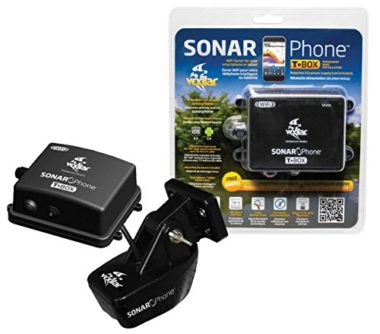
- Stand Out Features - Why We Love It
- Amazing chart plotter with Navionics integration
- Generates its own WIFI hotspot
- Water temperature and depth indicator
- Audible alarm for fish
- Fish icons and zoom bottom track
- Noise rejection and surface clarity
- Comes with a neoprene armband
- Two-year warranty on unit and one-year battery warranty
Dimensions: 7.2 x 3.8 x 5.8 in
Weight: 1 lb
Operating Depth: 240 ft
Operating Frequency: 200kHz
Beam Angle: 20/40°
Compatibility: iOS 4.3 and Android 2.0
Power Supply: 12 Volt
Garmin echoMAP 54cv
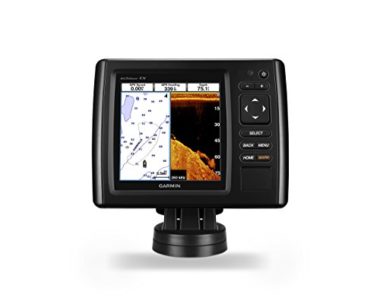
- Stand Out Features - Why We Love It
- Great fish finder for saltwater fishing
- ClearVu scanning sonar technology
- Accurate and reliable 5 Hz internal GPS
- Excellent chart plotter
- Built-in maps and ability to create own maps
- Crisp fish arches with great target separation
- A cover is part of the package
Dimensions: 6.8 x 1.7 x 5.4 in
Weight: 1.3 lbs
Operating Frequencies: CHIRP 50/200/455/800 kHz
Power Output: 500 W
Maximum Depth: 2300 ft
Lowrance HOOK2 4X
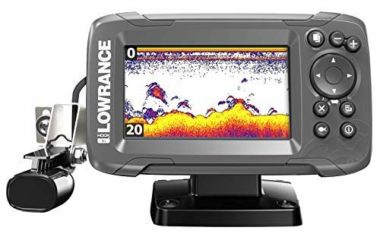
- Stand Out Features - Why We Love It
- Simple and inexpensive yet reliable fish finder
- Extremely easy to use and beginner-friendly
- Ideal size for small boats, kayaks, and canoes
- Auto-tuning sonar for automatic scanning and adjusting
- Broadband sonar coverage
- Variety of mounting options
- One-touch access to key features
Dimensions: 3.3 x 6.5 x 3.8 inches
Weight: 2.2 pounds
Operating Frequency: 200kHz
Sonar Beam: 40°
Transmit Power: 200w RMS
Humminbird Helix 5 DI
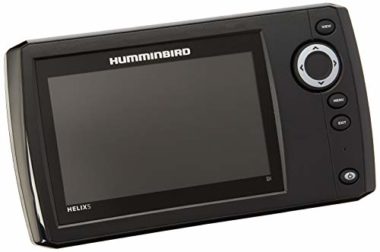
- Stand Out Features - Why We Love It
- 4000 wattage ideal for deep waters
- Detailed and fast data pickup
- Dual Beam PLUS Sonar and down imaging
- Multiple operating frequencies and cone angles
- Water surface temperature gauge
- Wide color display with backlight and split-screen view
- Optional GPS mapping
- International languages supported
Dimensions: 8.5 x 6 x 4 in
Weight: 3.75 lbs
Operating Frequencies: 455/800/200/455 kHz
Beam Angle: 16, 28, 45 and 75°
Wattage: 4000 Watts
Depth Capability: 600 ft sonar depth, 350 ft down imaging
Lucky Wired and Wireless Portable
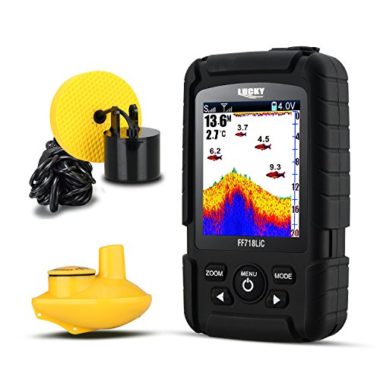
- Stand Out Features - Why We Love It
- Has a castable wireless mode and a mountable wired mode
- An integrated ice fishing flasher
- Sends both narrow and wide beam sonar
- Floating and waterproof design
- Fresh and saltwater operation
- The display has three color options
- Adjustable sensitivity, fish icons and alarms
- Compact and portable design
- Long battery life
Dimensions: 5 x 3 x 1.3 in
Weight: 6.7 oz
Operating Frequency: 200Khz wired and 125Khz Wireless
Beam Angle: 45° wired and 90° wireless
Depth Capability: Cable 328 ft, Wireless 147 ft
How To Choose A Fish Finder Under $300 – Buying Guide
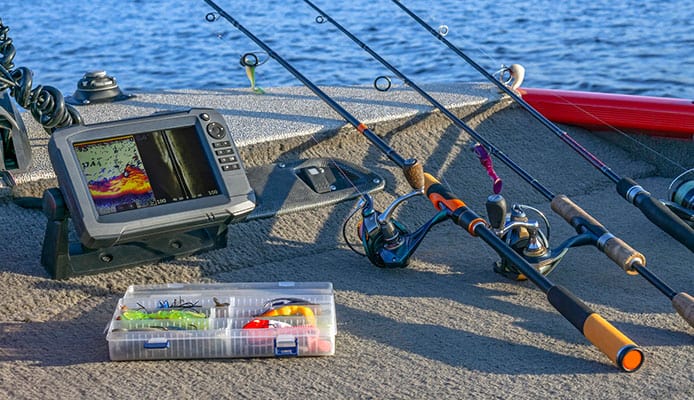
If you’re finding it hard to determine which fish finder under 300 is best for your needs, here are the things to assess as you look at the different options:
Use
How you intend to use the fish finder will determine the best fish finder under 300 for you. Will you be installing your unit on a motorized boat? With you be mounting it on a kayak or canoe? Do you want it for trolling? Will you be casting it from the shore?
If you’re a versatile angler who casts in freshwater as well as in saltwater and even jig through ice holes in the winter, you will need a versatile unit built to withstand a wide range of operating environment and equipped with a classic flasher for ice fishing.
Type
There are different types of fish finders on the market. How you intend to use your unit will determine the best type of fish finder to go for. There are fixed units that you can install on a boat. Castable fish finders you can attach to a fishing line and cast to scan a hard to access spot without spooking the fish. And hand-held ice fishing fish finders with built-in classic fish flashers. If you want a fish sounder you can use to map your route and save favorite fishing spots, you will need a fish finder with GPS capability.
Related Reviews: Castable Fish Finder & Lowrance Fish Finder
Transducer
The transducer is the technical component of a fish finder. It is the part that sends sound waves below the surface and receives the sonar readings. It is important to check what kind of transducer the fish finder you’re considering comes with. The three aspects of a transducer to consider are its operating frequency, cone angle, and wattage as explained below.
Frequency
The operating frequency tells you how deep or wide the sonar signal the transducer sends travels in the water. A high frequency signal such as 200 kHz transmits a more detailed and accurate image of the area directly below the transducer. A low frequency signal such as 83 kHz scans a wide area. If you fish in both shallow and deep water, go for a model with dual or multiple operating frequencies.
Cone Angles and Beams
The area covered by the sonar beam the transducer transmits is cone-shaped. The cone angle is the angle in which the sonar signal is sent from the transducer. The larger the angle, the wider the beam and the larger the area covered. A narrow beam penetrates deep into the water. A fishing sonar with dual-beam coverage will give you the best of both cone angles.
Wattage
Wattage tells you how powerful a fish finder is and how fast the signals it emits travel through the water. The higher the wattage, the higher the power and the deeper and faster the signal will travel. If you will be fishing in deep water, you will need a powerful fish and depth finder with a high wattage such as 4000 watts to send signals to great depths.
Display Screen Resolution
It doesn’t matter how sophisticated the transducer technology is if you can’t see and make sense of the data displayed. The display is, therefore, one of the most important parts of a fish finder and the screen resolution is an important consideration when choosing a fish finder. The higher the screen resolution, the better the image quality and clarity.
Display Screen Colors
A color display is not only vibrant and pleasing to look at, it is easy to read and you can see more detail about what is below the water than you can on a black and white screen. It is also easier to pick out the fish and resolve targets and bottom structure. The best fish finders under 300 can display hundreds of colors.
Power
Fishfinders require a source of power and it is important to confirm that you will be able to power your unit wherever you will be using it. There are fixed fish finders you can install on a boat and connect to a power supply. As for portable units, some are powered by disposable batteries while others have rechargeable batteries.
Portability
If you want a fish finder you can mount on a small boat, kayak or fishing canoe, carry wherever you go fishing or hold in your hand as you hop from ice hole to ice hole, a portable fish finder that is compact and lightweight is ideal. Some portable options even come with a protective carry case.
You might also be interested in:
GPS System
Choosing the best GPS fish finder under 300 will give you the ability to determine your location, map your routes and mark your favorite fishing spots so you can locate them again easily. A fish finder GPS combo will also offer you the best value for your money, as you don’t have to purchase a fishing GPS separately. You can even get a unit with chart plotting capability at this price point.
Waterproof
This is a device you will be using around water. It is bound to be splashed on, rained on, and even submerged accidentally. It should be able to withstand these kinds of scenarios without failing. A watertight construction that doesn’t allow water to penetrate through is important. Pay attention to the construction and waterproof rating if any.
Design and Durability
To ensure you end up with an easy to install and operate fish finder, pay attention to its design. Are the navigation buttons large enough and intuitively placed? What kind of mounting options does the unit offer?
Last but not least, you will want to ensure that you choose a quality fish finder that will give you long-lasting service. It should be sturdy and built to resist the elements it will be exposed to such as saltwater and sun. Choose a well-built unit offered by a reputable brand and check its reviews by users to find out how well it holds up.
FAQs
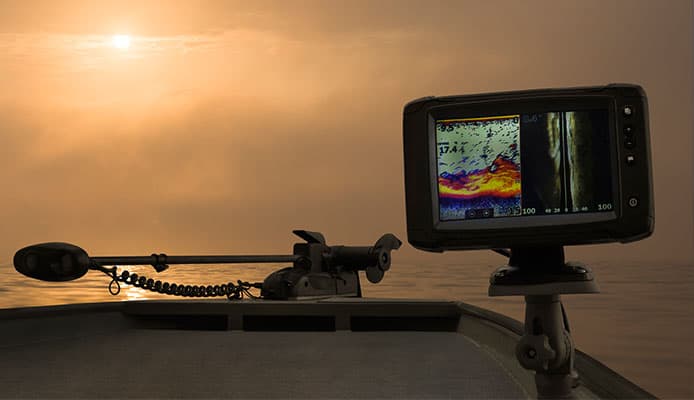
Q: What Is A Fish Finder?
A fish finder is a type of sonar device that utilizes sound waves to find fish and identify what is below the water.
Q: How Do Fish Finders Work?
Fishfinders utilize SOund Navigation And Ranging (SONAR) technology. The transducer, which is the technical component of a fish finder, sends sound waves below the surface of the water. These sound waves hit fish and other objects underwater and bounce back to the transducer. Using the time lapse between when the signal was emitted and when it returns, images of what’s underwater are created and displayed on the screen of your fish finder or on your smartphone or tablet.
Related Post: How To Read A FishfinderQ: Why Do I Need A Fish Finder?
Without the ability to see what is below the water, fishing is a guessing game and you can waste a lot of time casting or jigging spots with no fish. A fish finder gives you a way to find out whether there are fish where you’re fishing. It will also show you structure and bottom contour. A fish finder will up your fishing game and help you catch more fish.
Q: Can I Sync my Fish Finder with my Smart Phone or Tablet?
Yes, most fish finders can be synced with a smartphone or tablet. They come with an app that you download and install on your device. The fish finder then syncs with the app wirelessly. Some fish finders create their own WiFi hotspots and transmit a signal that is picked up by your device.
Q: Can I Use the Same Fish Finder for Shallow Water, Deep Water, And Ice Fishing?
Yes you can. You just need a fish finder that can transmit both high and low frequency beams for deep water and shallow water and has an in-built classic ice fishing flasher.
Globo Surf Overview
Whenever you get the opportunity to go fishing, you want to catch plenty of fish and enjoy the experience. A fish finder can help you maximize your angling excursions. When you know where the fish are, what size they are and have a picture of what is below the water, you are bound to have productive and enjoyable excursions.
With the best GPS fish finder under 300, you can explore and fish unfamiliar waters with confidence and mark the lucrative fishing spots you discover. All the fishing sonars in our best fish finder under 300 reviews are well built and have five-star ratings for their performance on the water! Happy fishing!

